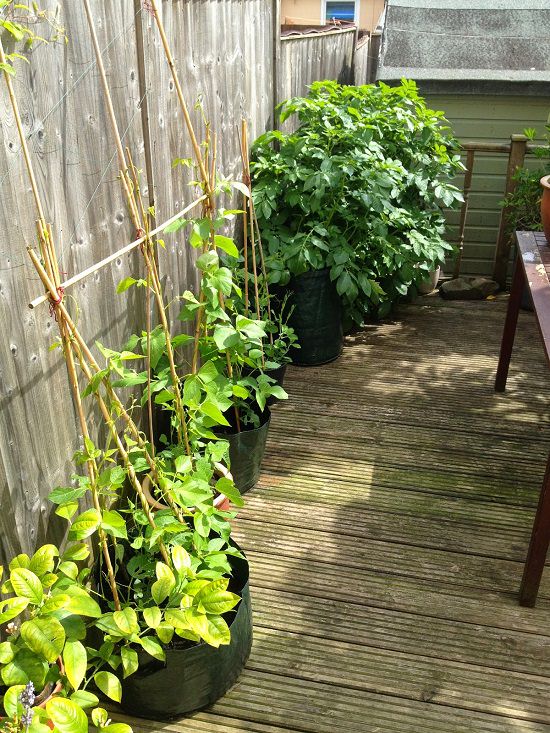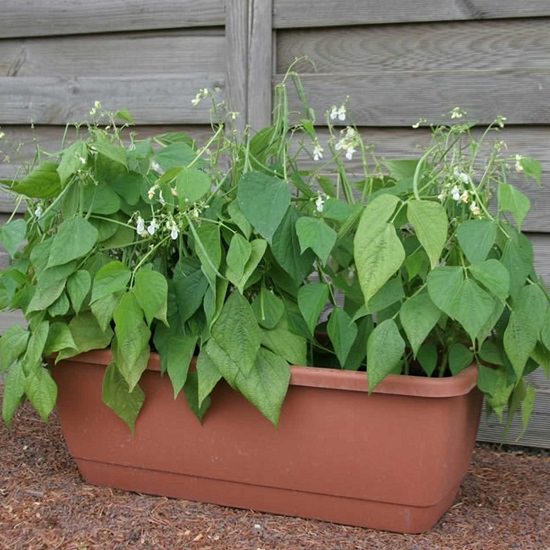Learn about Types of Beans and Best Green Bean Varieties that are productive and grow easily not only in garden beds but in Containers as well!
Green beans are basically divided in two–Pole beans and Bush beans. However, in this article, we further divided the Types of Beans to FIVE–Pole beans, Bush beans, Runner Beans, Lima Beans, and Shell beans. You’ll find the names of some popular and easy to grow green bean varieties that you can grow in the regular garden and container garden both.
The best thing about growing beans is once they are established, they don’t require much care. You can have ample supply of protein-rich, fresh, homegrown beans throughout the growing season. These vigorous growers can easily well in containers in a balcony, rooftop or patio.
Pole Beans
Pole beans are climbing beans that need a structure or pole to climb on. One great thing about growing pole beans is that they’ll produce higher yield vertically than bush beans and you can easily grow them in pots if you’re ready to provide proper support.
Blue Lake
The sweet, stringless, and tender beans of this variety are a treat for the tastebuds. The pods are about 5-7 inches long in which stringless, oval and dark green beans are present. You can have them fresh, frozen, canned, or baked as you like. The beans are ready for harvest in 62-75 days.
Emerite
Growing to a height of around 8 feet, this pole bean produces sweet and earthy flavored beans. Originally from Vilmorin, it’s a true filet with pods that are straight and slender. You can have the tender beans when they are young, around 4-5 inches long. Or pluck them when they are 7-9 inches long for crispy and brittle beans. The harvest time is 55-70 days.
Fortex
The pods can grow out to become 11 inches long and even more if allowed. You can also harvest them when they are 7 inches long if you love slender filet beans. Walnut brown seeds are somewhat sweet, meaty and savory in taste and go well with many dishes. Make sure to provide strong support. You can expect a harvest in 60-70 days.
Romano
This bean is famous in European countries and commonly used in Italian cuisine. The flavor is uncomparable and at its peak when the pods are young, so pluck them as soon as they are 5-6 inches long. The pole bean takes around 60-70 days to reach that stage.
Asian Winged
As the name suggests, this plant produces bean pods that have winged edges. Due to their unique appearance, they not only look great but are also delicious in taste. The whole plant is edible from roots to leaves. For optimum growth place it at a warm and humid spot, you can also install a humidifier.
Rattlesnake Pole
Although the name is quite frightening, this bean is not! Its pods grow in the exotic shade of dark green streaked with purple. It doesn’t mind sandy soil and resistant to drought. The 8 to 10 inches long pods will grow throughout the season if you pick them in every 2-3 days. The rich and sweet taste makes it a great addition to soups and stews.
Bush Beans
Do you find the whole process of installing a support structure too tedious? Then you should go for bush beans as they grow upright, and being a freestanding plant doesn’t require any support structure. You can plant them almost anywhere. Pole beans can also grow in containers, but it’s the bush beans that are more suitable for container gardening. Also, with bush beans, you can reduce your waiting time for harvest.
Blue Lake 274
The name might give you second thoughts about growing this variety but trust us the plump and tender beans are worth having in any garden. The plant is small in size and only about 12-22 inches tall. As the beans mature at once, it great for canning and freezing. Taking around 60 days to harvest this variety produce heavy yield and one of the types of beans we couldn’t miss adding.
Contender
You can have these raw in salads or cook them for a tasty and healthy meal. The pods will be ready for harvest in 40-55 days. One great thing about this variety is that it’s resistant to many diseases, pests, and also heat and mildew. The high yielding pods are somewhat curved, round and 6-8 inches long.
Bountiful
Another bush bean variety that’s resistant to bean beetles, rust, and mildew. The pods are stringless and take around 49 days for harvest. You can freeze or can the beans for storing and using them later. Both foliage and pods are light green in color with pods growing to about 6 inches in length.
Derby
The flavor is excellent when the beans are plucked young and tender. Oval and rounded dark green pods can grow to 7 inches in length. It’s tolerant to varying weather conditions and gets ready for harvest in 57 days. The beans are suitable for freezing and canning!
Provider
Germinating in cool soil, it’s weather tolerant once established. Not only that, but it’s also resistant to diseases. The beans take around 48-54 to be ready for picking. The pods are light green in color, stringless, round and can grow to about 6 inches long. They can be cooked, canned, freeze, and even pickled to retain the flavor.
Kentucky Wonder Bush
It’s a vigorous grower and also goes with the name Commodore and Old Homestead. Taking anytime between 52 to 65 days to harvest, the pods are fleshy and tender. You can grow them in almost any region as it’s very adaptable.
Runner Beans
Runner beans are grown as ornamental plants in North America for their bright flowers, but they’re quite popular edibles in Britain. Runner beans can be both bush or pole types, depending on the cultivar. You can grow them with other colorful vegetables for edible landscaping; they’ll also attract pollinators to your vegetable garden.
Scarlet Runner
This vigorously growing 10 feet long vine not only produces tasty green beans but is also known for gorgeous scarlet flowers and speckled burgundy & black seeds. The beans will be ready for harvest in about 70-80 days. Although for shelled beans you’ll have to wait for around 115 days.
Dragon’s Tongue
This heirloom bush bean variety produces beans after 60 days. It’s known for great flavor and unique yellow pods decorated with purple streaks. If you’re looking something colorful in your platter, grow it.
Moonlight
It’s a self-pollinating variety, which means you won’t require to cross-pollinate if pollinators are not available. Moonlight produces white flowers before fleshy, stringless 10 inches pods with real runner beans taste. Like other runner beans, it can produce in part sun and grows up to 10 feet tall.
Hestia
This dwarf runner bean variety grows up to 16 to 18 inches in height and produces a sufficient yield of tasty, slim and 8 inches long beans in 60 to 70 days. You can grow up to 4 plants in a container that is 8 inches deep and 10-12 inches wide.
Lima Beans
It’s a warm-season crop and native to Central America, which is rich in protein and many other nutrients such as thiamine, iron, and riboflavin. Lima beans are known for taste and richness in anti-oxidant, including them in the diet has many health benefits.
Henderson’s Bush
The bushy and upright plant is robust and healthy, which produces buttery flavored beans. It was popularized by Peter Henderson & Co. in 1888 and remains popular till date. They can be served boiled with butter, salt, and pepper or freshly pickled and cooked. Ready for harvest within 70 days, the pod size is 4-5 inches.
Fordhook 242 Bush
This nutty-flavored bean is delicious. It can tolerate both drought and heat and other adverse conditions. The thick pods are 3-4 inches long and greenish-white. Being a bush variety, it doesn’t require support and thrives in humidity. You can expect a harvest in 70 to 85 days.
Dixie Butterpea White
The plant can reach a height of 16 to 23 inches with pod length being 3-4 inches long. The beans have a succulent-like texture and meaty taste with around 3-4 round seeds in each pod. As it does well in hot weather, make sure to place the pot in a warm spot. It’s the right choice for the container gardeners in a hot climate.
King of the Garden
The vines can go up to a height of 10 feet although it can be pruned back. The beans take a quite long time to be ready for harvest, around 85 to 90 days, but the quality is excellent. The large-sized pods can be canned, frozen, or served fresh.
Shell Beans

The shell beans are shelled for the seeds and eaten without the pods, unlike green beans. The nutritional value remains the same to dried beans, and the beans are harvested when the pod and the seeds inside, both turn dry.
French Horticultural
Growing up to 18 inches tall; this bush bean produces bright green pods which turn to a beautiful shade of red and yellow with time. It’s a highly productive and sturdy plant that is also resistant to many diseases. The pods can grow 6-8 inches long with purple seeds inside. You’ll need to wait for 90 days before harvesting if you prefer it shelled.
Black Turtle
The small and shiny black beans of this variety look so exotic that they make you think twice before cooking. This bean is richer than all other beans when it comes to the antioxidant content. Make sure to cook, stew, or refry it as it contains toxic lectins, you can also prepare black bean soup. It takes 85 to 105 to mature and is hardy and heat resistant.
Vermont Cranberry
The maroon speckled beans of this variety are oval with an excellent taste and superior quality. There are 5 to 6 seeds per pod. You can obtain it as fresh shell bean in 60 days and dry bean in 85 days. A very popular new England heirloom, this easy to shell variety dates back to the 1700s.
Navy
Why this name? Because this bean was a staple food for the US army back in the 20th century. The beans are creamy-white and grow inside a 4-inch long pod. The high yielding plant can become 16 to 24 inches tall. The beans have a nutty and mild flavor that tastes delicious when baked, stewed, or added to soups.







Sparkling writing!! Thanks buddy for such a great information!!
Thanks for giving us the full meal deal. I’m trying
Fortex this year.